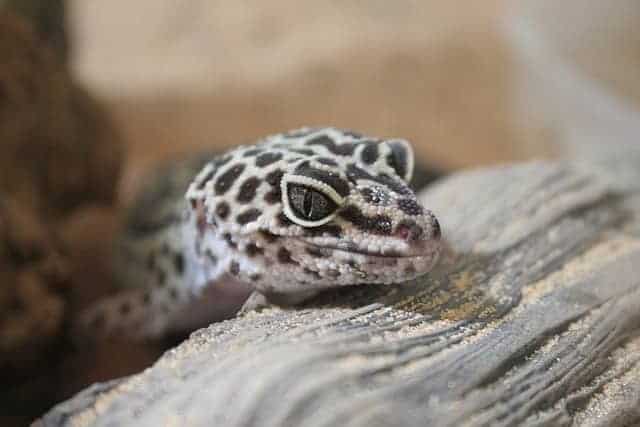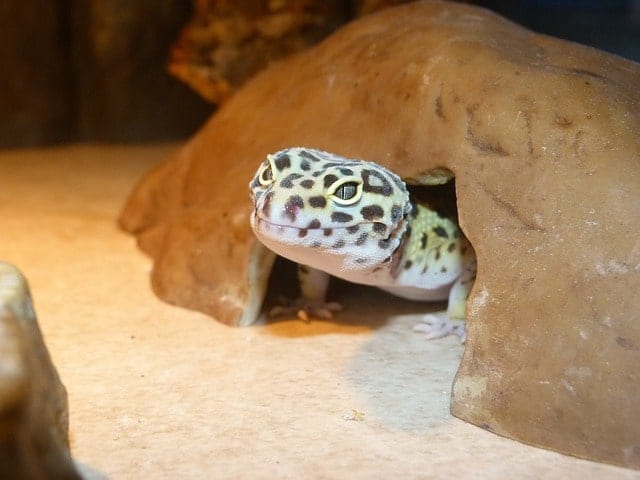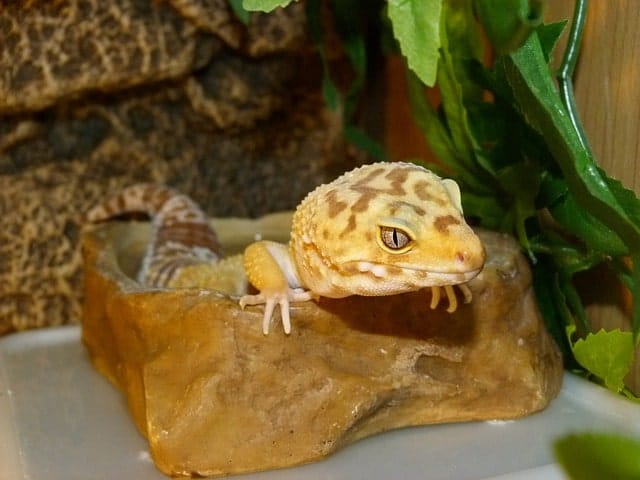One of the most integral parts of keeping a pet is ensuring it lives in an environment that provides a healthy and happy life. While leopard geckos are considered the least complicated reptile pets to care for, setting up their habitat requires more than placing light fixtures and a few rocks.
One common misconception is that since leopard geckos come from the deserts of Asia, their habitats should have low humidity. On the contrary, these creatures need humidity levels between 30% and 40% on a normal day. However, when shedding, you need to provide them with a humidity of 70% to 80%.
Since it’s not practical to maintain optimal tank humidity and still provide moist conditions that are ideal for shedding, this is why you need a humid hide inside your leopard gecko’s terrarium.

Why Do Leopard Geckos Need Humid Hide?
Leopard geckos use the moist hide to regulate their body temperature and obtain additional moisture for shedding.
Pregnant leopard geckos have been known to lay their eggs in damp hides. Therefore, your leopard gecko’s terrarium won’t be complete without a humid hide.
Even though leopard geckos’ natural habitat is the rocky deserts of Asia, they conceal themselves in damp areas during the day to escape the scorching sun.
Higher humidity is required for successful shedding in leopard geckos. This is the primary reason why you need to provide them with a humid hide.
Low humidity makes it hard for geckos to shed and can even make their shed stick to their bodies. If this stuck shed isn’t taken care of, it could stay stuck for a long time and cause extensive damage.
In fact, some keepers had to cut off leopard gecko tails and toes because of retained shed that led to necrosis.
Many first-time keepers assume leopard geckos thrive in dry habitats with less moisture. They make humidity blunders that often lead to severe health complications and a reduced lifespan.
However, the truth is that leopard Geckos need moisture. Without it, they can lose water quickly and have difficulty shedding.
How to Create a Humid Hide for Your Leopard Gecko?
Creating a humid hide is not a complicated process. You can create a leopard gecko’s moist hide using common household items such as a plastic container, small box, or flower pot. Conversely, a coconut husk with interior contents removed can make a great hide.
Whatever you choose to use for the hide, make sure it’s big enough for your lizard to move around.
What You Need to Make a Humid Hide
Container
A container is the first thing you’ll need to make a moist hide for your lizard. While you can use various containers as the base for your humid hide, you must consider the material. Glass does a good job in heat and moisture retention, but it can get too hot sometimes.
Plastic containers are better because they boast a high melting point, which means they won’t melt even when the cage is hot. Leopard geckos require a ground temperature of 86 to 92 degrees Fahrenheit when measured at the hottest point.
When selecting a container, there are two integral factors that you need to consider; size and heat tolerance. Generally, the container should be twice or thrice as big around as your Leopard Gecko.
If the container is too small, the scaly friends may feel like they are being squished. But as long your gecko can curl up inside the moist hide and spin around freely, that’s all that matters.
Adults are usually seven to ten inches long, so a moist hide that is 7″x4″x4″ should work well. Containers made of recycled plastic, such as those used to store deli meat or margarine, are ideal.
In most cases, these containers will come equipped with lids, making replacing the substrate a breeze.

Substrates
Your reptile friend will spend significant time in the moist hide. So, you must choose something that provides comfort and maintains high humidity levels. Some of the commonly used substrates in moist hides include:
Sphagnum moss/ peat moss
Pros
- Cheap and easy to find
- Antimicrobial properties
- Holds moisture well
- Natural
Cons
- Must be mixed with another substrate to create a perfect laying ground for female geckos
- It needs to be washed after every two weeks
When choosing the floor for your humid hide, peat or sphagnum moss make excellent substrates as they help maintain high humidity levels.
Due to its antimicrobial and moisture-retaining properties, moss makes the best substrate for a moist hide.
Place approximately two inches of sphagnum/peat moss inside the moist hide and spray it with water. When the sphagnum moss starts to dry, lightly mist it with water, taking care not to soak it.
Coconut Fiber
Pros
- Ideal for digging
- Natural and doesn’t contain toxins
Cons
- It can get moldy over time
- It has loose particles that may cause impaction
- It may get dusty when dry
Coco fiber, also known as coconut fiber, is another substrate many leopard gecko owners use in humid hides. It is conducive for burrowing and digging, making it suitable for females that lay eggs.
One drawback of coconut fiber is that it can cause impaction, especially for babies and juveniles.
Keep an eye on the moisture content of the coco fiber, as it can become dusty and easily inhaled or ingested when dry. Avoid using this substrate on baby leopard geckos.
Paper Towels
Pros
- It doesn’t cause impaction
- Ideal for baby geckos
- Easy to install and change
Cons
- It’s not natural
- Can’t be used in cages housing egg-laying females
- It needs to be replaced weekly
If you must use paper towels, invest in some heavy ones. If not, they’ll be easily torn.
Scissors
The last thing you’ll need to create a humid hide is a pair of scissors. This will be used to cut an entry path that leopard geckos will use to get into the hide.

A Step-by-Step Process of Making a Humid Hide
Step 1: Find the Right Container
Look for a recycled deli or margarine container twice or thrice the size of the leopard gecko. Thoroughly wash it and rinse it with clean water. Since most adult geckos are about 7 to 10 inches, a plastic container measuring 7″x4″x4″ will be enough.
Step 2: Cut an Entry Hole with Scissors or a Pair of Scissors
Cut an entrance about four inches wide and three inches tall using scissors. Since geckos have very sensitive skin, you should ensure that there are no sharp edges that can prick or hurt their skin.
Step 3: Add the Substrate
As mentioned earlier, the ideal substrate for your gecko’s moist hide is sphagnum or peat moss. Add two inches of sphagnum or peat moss into the hide, ensuring it covers the entire floor. Only use paper towels if you can’t access moss.
Step 4: Mist the Hide
Once you have installed the substrate, mist the hide using distilled water. Avoid soaking the substrate completely and ensure that the hide is not flooded.
Too much moisture will create a conducive environment for the growth of pathogens, leading to breathing complications.
Step 5: Put the Hide inside the Terrarium on the Warm Side
The moist hide should be placed on the warm side as placing it on the cool side can make it cold, which might lead to respiratory problems in leopard geckos.
Step 6: Ensure That There Is Optimal Temperature and Humidity inside the Humid Hide
For the humid hide to work as intended, the temperature should be maintained around 80-90°F. And since the humid hide is meant to provide ideal shedding conditions, the humidity levels should range between 70-80%.

FAQs About Leopard Gecko Humid Hide
Which Is the Ideal Place to Put the Humid Hide?
As mentioned, the humid hide should be on the warmer side of the tank. Putting it on the cooler side can make it too cold to the extent that it will make the leopard gecko sick. However, avoid putting the moist hide directly under the basking light, as the extreme temperatures in the zone can make the moisture evaporate.
My Leo Isn’t Using the Moist Hide. Should I Be Worried?
If the leopard gecko is new to your home or you added the humid recently, it will take a moment for the scaly reptile to be used the humid hide. However, your lizard may refuse to get into the moist hide if it’s not properly set up, too small, too hot, or the entry is not big enough.
Final Verdict
The key to making a perfect humid hide for your leopard dragon is ensuring it is a cozy home where the gecko can easily enter and exit. Ensure your reptile has enough space to play and explore inside the enclosure.
.